Order of Science and Technology 과학기술훈장 (科學技術勳章)
The Order of Science and Technology Merit is awarded to those individuals who have excelled in the areas of Science or Technology.
Until the creation of an Order for Science and Technology, the Korean Government had a problem in selecting a suitable award for achievements in science and technology. The original Order of Cultural Merit, 1951 Series, could be awarded for increasing production. These technology awards were later covered under the Order of Industrial Service Merit when it was created in 1962. The award criteria for the Order of Civil Merit, 1967 series, included a provision for Science Awards. But which Order is given for a scientific discovery that dramatically changes the technology, which in turn increases production? The following table aptly demonstrates the confusion. The table also gives some indication that in 2000, the government was searching for a solution to the problem.
There are several websites, including Korean websites, which state the before that Order of Science and Technology was established, the Order of Industrial Service Merit had been bestowed to scientists and technologists. But the table from the Ministry of Science and Technology (MOST) disproves that.
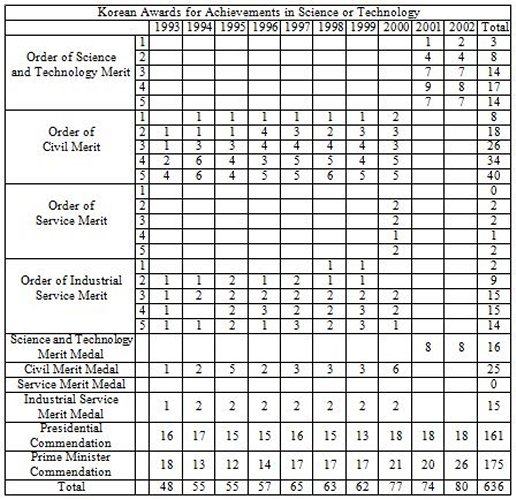
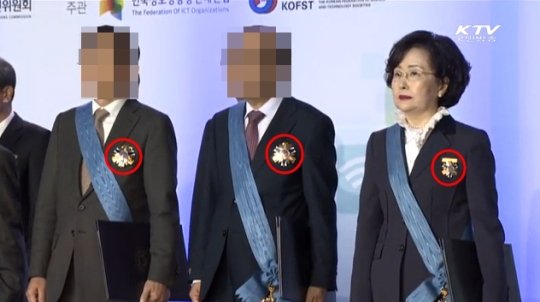
Red circles were added to point out the size discrepancy of the Breast Star, but the picture also shows a discrepancy in the width of the sash. The faces of the two male recipients have been obscured because they played no part in the slight against women.
ⓒKTV 캡쳐화면 출처 : 여성신문(https://www.womennews.co.kr)
The Order of Science and Technology has made a somewhat small but significant change to all of Korea’s Orders of Merit, including the Grand Order of Mugunghwa. On the April 21, 2015, Science Day in Korea, a ceremony was held in which the Order of Science and Technology was awarded. The highest honor of the Order of Science and Technology Medal, the Changjo Medal, was awarded to three people: Kim Myeong-ja 김명자, Yang Dong-yeol 양동열, and Kim Won-bae 김원배. Of the three recipients, Kim Myeong-ja was the only female. When looking at the size of her award in comparison to that of the other two male recipients, the size difference was conspicuously noticeable. Many Koreans wondered if she had received a lesser medal than the other two male recipients of the same class. Newspapers and women’s rights groups were quick to respond to the size difference, and questioned why, in these times, women get a smaller medal.
In 1967, the first legislated women’s sizes were approved. The Decorations Act that was in effect at the time, under Article 27 “Composition of the Orders and Medals”, Section ⑦ states: “The matters related to the badges, breast stars, ribbon bars and lapel pins and the collar decorations as set forth in the Items 1 to 6 in this Article and the shapes, sizes, colors, and materials of the cordons shall be determined by Presidential Decree.”1 The ‘Presidential Decree’ that it referred to, would be the Decorations Law Enforcement Decree. The following month, a new Decorations Law Enforcement Decree came into existence. This is the first legislation which dealt with specific sizes for women. Under Article 13 “Layout and Standards” (제13조 제식 및 규격) readers were directed to Appendix 3 (별표 제3) which specifically spelled out the newly created sizes for women.2 Nowhere in any legislation of that time, or in any subsequent legislation, does it spell out the reason for the women’s sized awards. It is generally understood that the government was trying to establish a more aesthetically appropriate award to compensate for the generally smaller frame size of women.
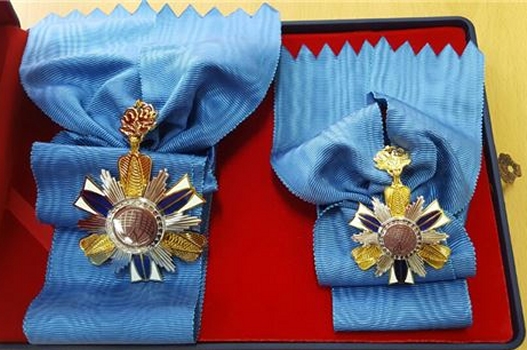
After the award ceremony mentioned above, there was a significant change made when a new Decorations Law Enforcement Decree was passed in 2016.1 In that legislation, there are no sizes specific to women, not even for the Grand Order of Mugunghwa, which previously had smaller sizes for both male and female spouses of heads of state.
2001 SERIES
An Order of Science and Technology Merit was created under Decorations Law #6342 on Jan. 8, 2001 in 5 classes. The Order became effective under the Decorations Law Enforcement Decree #17183 on Mar. 31, 2001. The base color for all the ribbons is blue/purple 청보라색 with white 백색 stripes. The sundial that is found in the centers of the pendants, breast stars and lapel pins is not found on the ribbon bars.
The Classes are:

- Changjo (Creation) 창조장 The pendant has a diameter of 70 mm and weighs 106 g. It is suspended from an 80 x 1,800 mm solid blue/purple 청보라색 sash with no stripes. The breast star has a diameter of 80 mm and weighs 132.0 grams. The ribbon bar is 38 × 10 mm. It has two white 백색 stripes, each 6 mm wide, with one on each side of the 24 mm blue/purple center stripe. The lapel pin is 12 × 8 mm and has two white stripes, 1.5 mm each, with one on each side of the 4 mm blue/purple center stripe.
- Changjo (Creation) 창조장 (sized) for Ladies. The pendant has a diameter of 50 mm and weighs 57 g. It is suspended from an 65 × 1,800 mm solid blue/purple 청보라색 sash with no stripes. The breast star has a diameter of 55 mm and weighs 75.0 grams. The ribbon bar is 38 × 10 mm. It has two white 백색 stripes, each 6 mm wide, with one on each side of the 24 mm blue/purple center stripe. The lapel pin is 12 × 8 mm and has two white stripes, 1.5 mm each, with one on each side of the 4 mm blue/purple center stripe.
- Hyeoksin (Reformation) 혁신장 The pendant has a diameter of 60 mm and weighs 87 g. It is suspended from a 38 × 600 mm blue/purple 청보라색 cravat with eight white 백색 stripes, each 1.5 mm wide, with four on each side of the 13 mm, blue/purple center stripe. The breast star has a diameter of 70 mm and weighs 113 g. The ribbon bar is 38 × 10 mm. The stripe pattern on the ribbon bar mimics the cravat, in both the colors and in the width of the stripes. The lapel pin is 12 × 8 mm. It also has eight white stripes, each .2 mm wide, with four on each side of the 4 mm blue/purple center stripe.
- Ungbi (Great Achievement) 웅비장 The pendant has a diameter of 50 mm and weighs 57 g. It is suspended from a 38 × 600 mm blue/purple 청보라색 cravat with six white 백색 stripes, each 1.5 mm wide, with three on each side of the 19 mm blue/purple center stripe. There is no breast star. The ribbon bar is 38 × 10 mm. The stripe pattern on the ribbon bar mimics the cravat, in both the colors and in the width of the stripes. The lapel pin is 12 × 8 mm. It also has six white stripes, each 0.2 mm wide, with three on each side of the 5 mm, blue/purple center stripe.
- Doyak (Leap) 도약장 The pendant has a diameter of 50 mm and weighs 55 g. It is suspended from a 38 × 100 mm blue/purple 청보라색 breast ribbon with four white 백색 stripes, each 1.5 mm wide, with two on each side of the 24 mm, blue/purple center stripe. The ribbon bar is 38 × 10 mm. The stripe pattern on the ribbon bar mimics the cravat, in both the colors and in the width of the stripes. The lapel pin is 12 × 8 mm. It also has four white stripes, each 0.3 mm wide, with two on each side of the 5 mm blue/purple center stripe.
- Jinbo (Progress) 진보장 The pendant has a diameter of 50 mm and weighs 55 g. It is suspended from a 38 × 100 mm blue/purple 청보라색 breast ribbon with two white 백색 stripes, each 2 mm wide, with one on each side of the 30 mm blue/purple center stripe. The ribbon bar is 38 × 10 mm. The stripe pattern on the ribbon bar mimics the cravat, in both the colors and in the width of the stripes. The lapel pin is 12 × 8 mm. It also has two white stripes, each 0.5 mm wide, with one on each side of the 5 mm blue/purple center stripe.
CURRENTLY
Since 1984, the Decorations Law Enforcement Decree has been changed 19 times. The current legislation is Decree #30517 and was enacted on March 10, 2020. In the intervening years, the only major change was to the Changjo (Creation) 창조장 (sized) for Ladies. As mentioned above, it was found to be discriminatory and was dropped in 2016.3 The only other change was that the blue/purple 청보라색 color of the earlier legislation is now rendered as purple 보라색. All the sizes, patterns, etc., of the 2001 legislation, are still in effect.

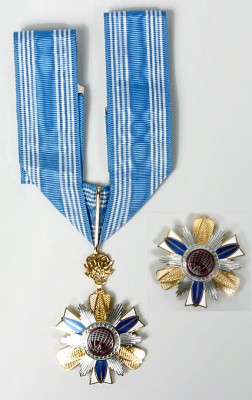
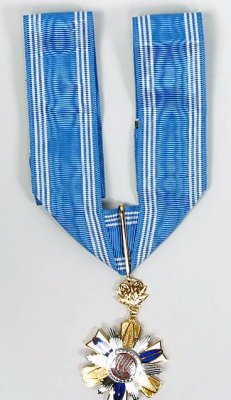
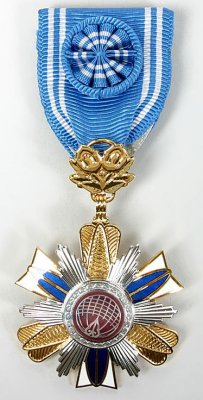
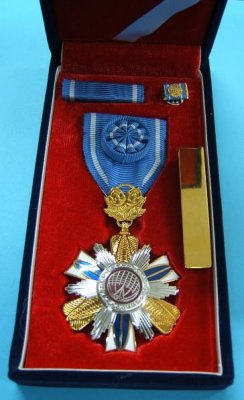
Footnotes:
- Decorations Law Enforcement Decree 상훈법 시행령, Presidential Decree #26838 대통령령 제26838호, dated 2015.12.31 and implemented on 2016.1.1.[시행 2016.1.1.], partial revision 일부개정.
- Bu 부 (釜) refers to a pot, Angbu 앙부 (仰釜) refers to a pot that looks up to the sky, and Gu 구 (晷) refers to a shadow, and Ilgu 일구 (日晷) refers to a sundial.
- Decorations Law Enforcement Decree 상훈법 시행령, Presidential Decree #26838 대통령령 제26838호, dated 2015.12.31 and implemented on 2016.1.1.[시행 2016.1.1.], partial revision 일부개정.
